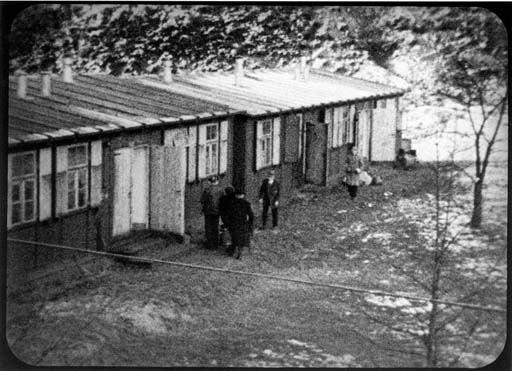Street view showing today’s Radeburger Strasse with former camp entrance to the left
- Preface 2 – On November 23, 1942, 279 Jews, the overwhelming majority of those left in Dresden who were not in mixed marriages or otherwise “privileged,” were forced to move to some newly erected barracks at Hellerberg. **pVIII
- 1942 November 24, Tuesday morning (First frosty day, firm snow on roof and streets) “Jews’ Camp Hellerberg.” Eva said this new kind of evacuation is so shameless. What is undoubtedly new is that this time we have a view of the inferno and remain in contact with it. Is it a moderate hell? That remains to be seen. Young Eisenmann, who helped stuff the bedding, etc., said: “Catastrophic!” Unimaginably crowded and barbarically primitive, especially the latrines (in a row without dividing walls and far, far too few), but also the narrow beds, etc. The carpenters had said they had worked on barracks for Russian and Polish prisoners — luxury hotels compared to this Jews’ camp in the sand and mud! **p168
- Notes p522 – [1943] February 28 — evacuation was imminent: At the end of February 1943, Commissar Schmidt (see note, December 11, 1942) received an order from Adolf Eichmann in person to liquidate the Hellerberg camp. During the night of March 2-3, the in- mates were taken to Dresden-Neustadt goods station, loaded into cattle trucks, and deported to Auschwitz. The transport, which eventually consisted of thirty trucks containing several thousand people, arrived at Auschwitz-Birkenau on the evening of March 3. The majority were “selected” on arrival and had to make their way directly from the ramp to the gas chambers. **p522

- Credit and further information: Stiftung Saechsische Gedenkstaetten
- German Wikipedia article about the camp
- Historic video footage: Last Jews in Dresden into the camp at Hellerberg on 23/24 November 1942
Source:
- **I Will Bear Witness, Volume 2: A Diary of the Nazi Years: 1942-1945, Victor Klemperer, Publisher : Modern Library; Illustrated edition
Purchase on Amazon: